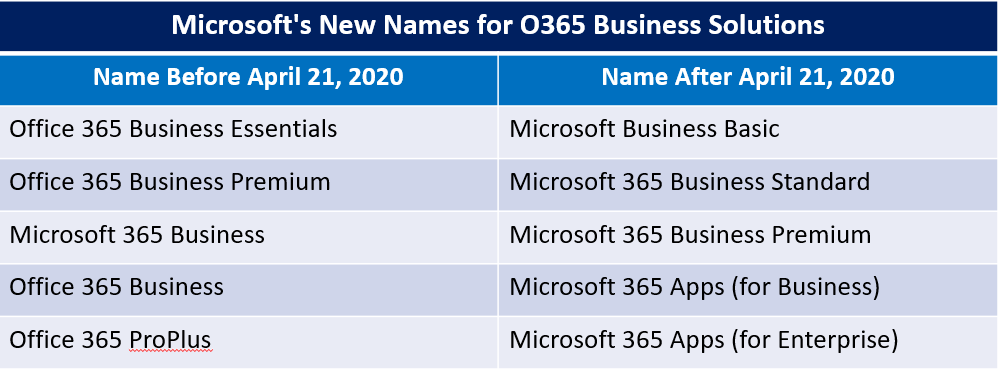- Adam Mansfield
- Reading Time: 4 minutes

Microsoft’s recent announcements will impact consumers, small businesses and enterprise customers.
In 2016, Microsoft rebranded it’s Enterprise Cloud Suite (ECS) and introduced it as the new Secure Productive Enterprise (SPE) which had two tiers: E3 and E5. As part of the change, they also renamed Enterprise Mobility Suite to Enterprise Mobility Security to reflect “new security value” that they brought to the offering. These changes years ago were designed to encourage enterprises to more readily associate their products with “productivity” and “security” as the name suggests. Now, Microsoft is making changes to shift the mindset of consumers and small- to medium-sized businesses to ramp utilization with the ultimate end goal of ramping enterprise adoption.
A Microsoft 365 Bundle for Consumers
In 2017, Microsoft rebranded its SPE offering and released Microsoft 365 (M365) as a cloud subscription bundle for enterprise customers that consists of Office 365 (O365), Windows 10 Enterprise, and the Enterprise Mobility + Security (EMS) suite. However, Microsoft recently announced that for the first time there will be Microsoft 365 bundles for consumers. The newly introduced M365 Personal and M365 Family subscriptions will replace and be priced the same as the existing Office 365 (O365) Personal ($6.99/month) and Home plans ($9.99/month for up to 6 people). The consumer M365 cloud subscription bundles include access to Outlook, Office desktop apps for Windows and MacOS, OneDrive, Skype call recording, 60 minutes of Skype landline and mobile phone calls, Windows 10 tech support as well as additional security features to protect from phishing and malware attacks.
In addition to these differences between the consumer O365 subscriptions and the M365 Personal and Family subscriptions that will be available on April 21st, there is also an intentional name change involved which puts the name “Microsoft” front and center. With these enhanced and rebranded offerings, Microsoft is not only trying to create subscriptions that give consumers what they need in their personal life, they are also attempting to shift the mindset of these consumers so they associate its products with “Microsoft 365” – the product that they’ve been pushing enterprises to use.
Knowing that many consumers also work at enterprises, Microsoft is smart to focus more attention on the consumer market even if that also includes simply renaming their consumer products to match its enterprise subscriptions. Giving consumers what they want helps motivate adoption and adoption leads to use which helps familiarize these individual consumer users with the M365 product. Microsoft understands that getting consumers to use the M365 cloud subscription could help accelerate enterprise use of M365 because enterprises that employ these consumers may be more likely to implement a solution that their employees are already familiar with and can start being productive with right off the bat.
New Teams Offering for Consumers
Microsoft also announced a new Teams consumer edition, “Teams for Life”. This announcement is heavily tied to what’s going on with COVID-19 where there has been an unprecedented spike in Teams usage (like there has been with Zoom, Slack, Google Hangouts, etc.) as collaboration vendors try to provide solutions to help people interact with each other while working remotely or simply living remotely (which includes families and classmates). They currently have 44 million daily users of Teams, up 12 million in just the last week. So, Microsoft announced that they will release a Teams consumer edition later this year with the ability to sign up for a “Teams for Life” preview now. This does not come as any real surprise and with Zoom’s recent security issues, there is going to be a lot of businesses, schools, and individuals looking to jump to something new. In Microsoft’s mind, why not Teams?
The goal here is to provide these consumers the ability to seamlessly shift between their personal and work Teams. Creating a solution that individuals can become comfortable and productive with on their own drives awareness of the Microsoft solution. This familiarity ultimately allows Microsoft to call on their enterprise customers, where they’re having difficulty getting adoption of Teams, to reference the fact that these consumers are using the solution on a personal level, which will make them more productive on the very first day the business adopts the solution.
If Microsoft can get consumers to use their products more than Google, Slack, or Zoom, they will be able to further find ways to keep these competitors out, preventing them from penetrating Microsoft-targeted enterprises.
Rebranding Business Solutions to Make “Office” Work Synonymous with “Microsoft”
Also effective April 21st, there will be a rebranding of O365 business solutions. There won’t be any new features, just new names for the products designed for small- and medium-sized businesses. The theme here is effectively removing “Office” from the brand of their productivity solutions for these sized businesses and shifting to a collective mindset of “Microsoft 365” rather than “Office 365” — very similar to what they are doing on the consumer front. In short, they’re rebranding their products to put “Microsoft” as a brand name front and center, minimizing and removing “Office.”
Here is a quick summary of the changes:

Microsoft has stated in their announcement that these changes represent an ambition to drive innovation in M365 that goes well beyond what customers traditionally think of as Office. The key part here is “think of”. At the heart of all of these changes is the ambition to shift the mindset around their solutions to one that is more aligned with their name brand and the all-in cloud solution they’ve been aggressively pushing, M365.
Comment below, follow me Adam Mansfield on Twitter @Adam_Mansfield_, find my other UpperEdge blogs and follow UpperEdge on Twitter and LinkedIn.
What to Read Next
Related Blogs
SaaS Price Increases: What If Vendors Only Charged More When You Got More?
Microsoft Ends EA Volume Discounts: What It Means and How to Respond
Hyperscaler Renewals: Strategic Takeaways for CIOs and Infrastructure Leaders
About the Author
